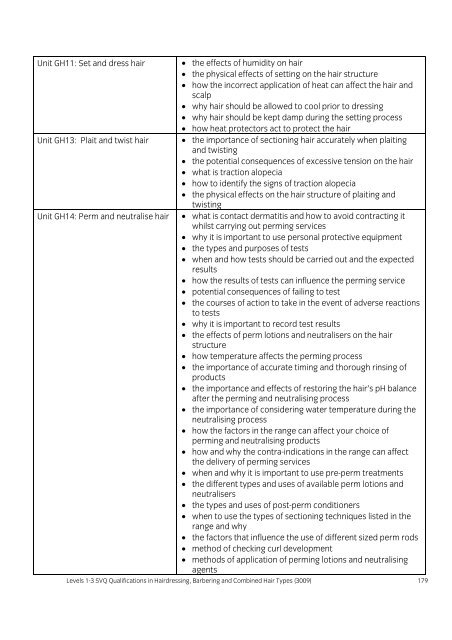3009 SVQ Assessment handbook v2 - City & Guilds
3009 SVQ Assessment handbook v2 - City & Guilds
3009 SVQ Assessment handbook v2 - City & Guilds
Create successful ePaper yourself
Turn your PDF publications into a flip-book with our unique Google optimized e-Paper software.
Unit GH11: Set and dress hair<br />
Unit GH13: Plait and twist hair<br />
Unit GH14: Perm and neutralise hair<br />
• the effects of humidity on hair<br />
• the physical effects of setting on the hair structure<br />
• how the incorrect application of heat can affect the hair and<br />
scalp<br />
• why hair should be allowed to cool prior to dressing<br />
• why hair should be kept damp during the setting process<br />
• how heat protectors act to protect the hair<br />
• the importance of sectioning hair accurately when plaiting<br />
and twisting<br />
• the potential consequences of excessive tension on the hair<br />
• what is traction alopecia<br />
• how to identify the signs of traction alopecia<br />
• the physical effects on the hair structure of plaiting and<br />
twisting<br />
• what is contact dermatitis and how to avoid contracting it<br />
whilst carrying out perming services<br />
• why it is important to use personal protective equipment<br />
• the types and purposes of tests<br />
• when and how tests should be carried out and the expected<br />
results<br />
• how the results of tests can influence the perming service<br />
• potential consequences of failing to test<br />
• the courses of action to take in the event of adverse reactions<br />
to tests<br />
• why it is important to record test results<br />
• the effects of perm lotions and neutralisers on the hair<br />
structure<br />
• how temperature affects the perming process<br />
• the importance of accurate timing and thorough rinsing of<br />
products<br />
• the importance and effects of restoring the hair’s pH balance<br />
after the perming and neutralising process<br />
• the importance of considering water temperature during the<br />
neutralising process<br />
• how the factors in the range can affect your choice of<br />
perming and neutralising products<br />
• how and why the contra-indications in the range can affect<br />
the delivery of perming services<br />
• when and why it is important to use pre-perm treatments<br />
• the different types and uses of available perm lotions and<br />
neutralisers<br />
• the types and uses of post-perm conditioners<br />
• when to use the types of sectioning techniques listed in the<br />
range and why<br />
• the factors that influence the use of different sized perm rods<br />
• method of checking curl development<br />
• methods of application of perming lotions and neutralising<br />
agents<br />
Levels 1-3 <strong>SVQ</strong> Qualifications in Hairdressing, Barbering and Combined Hair Types (<strong>3009</strong>) 179
















